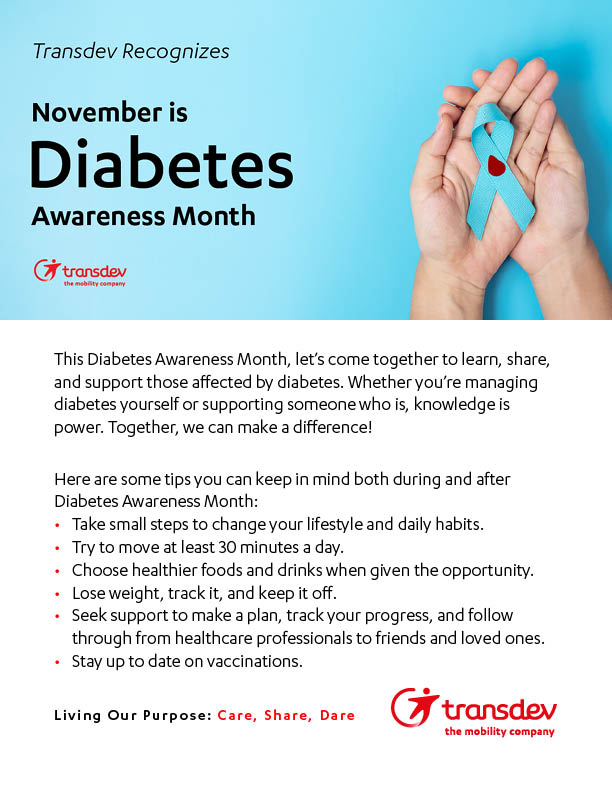As part of our ongoing commitment to health and safety, we are continuing to raise awareness around some health-related issues.
November is Diabetes Awareness Month. Diabetes is the name given to disorders in which the body has trouble regulating its blood-glucose, or blood-sugar, levels.
Throughout the month, we will offer some tips to help prevent or even reverse the onset of pre-diabetes.
First, let’s learn about the different types of diabetes:
- Type 1 diabetes (T1D) is an autoimmune disease where insulin-producing cells are destroyed by the body’s immune system. T1D seems to be genetic. It can be diagnosed early in life or in adulthood. Its causes are not fully known. People with T1D are dependent on injected or pumped insulin to survive.
- Type 2 diabetes (T2D) is often diagnosed later in life and can be due to genetic predisposition or behavior. T2D is a metabolic disorder in which a person’s body still produces insulin but is unable to use it effectively. It can be managed with diet and exercise or medication.
- Pre-diabetes is a serious health condition where your blood sugar levels are higher than normal, but not high enough yet to be diagnosed as Type 2 diabetes. According to the CDC, more than 1 in 3 U.S. adults have pre-diabetes—that’s 88 million people—but the majority of people don’t know they have it.
The good news is that by making small healthy lifestyle changes, it is possible to prevent Type 2 Diabetes and even reverse your Pre-Diabetes.
You can do so by:
- Taking small steps. Making changes to your lifestyle and daily habits can be hard, but you don’t have to change everything at once. It is okay to start small. Remember that setbacks are normal and do not mean you have failed—the key is to get back on track as soon as you can.
- Moving more. Limit time spent sitting and try to get at least 30 minutes of physical activity, 5 days a week. Start slowly by breaking it up throughout the day.
- Choosing healthier foods and drinks when given the opportunity. Pick foods that are high in fiber and low in fat and sugar. Build a plate that includes a balance of vegetables, protein, and carbohydrates. Drink water instead of sweetened drinks.
- Losing weight, tracking it, and keeping it off. You may be able to prevent or delay diabetes by losing 5 to 7 percent of your starting weight.
- Seeking support. It is possible to reverse pre-diabetes. Making a plan, tracking your progress, and getting support from your health care professional and loved ones can help you make the necessary lifestyle changes.
- Staying up to date on vaccinations. The COVID-19 booster and flu vaccines are especially important for people who may be more likely to get sick from a weakened immune system, such as people with diabetes.
Remember Thursday, November 14 is World Diabetes Day.
This day is an opportunity for everyone to take steps toward a healthier lifestyle and show solidarity with the millions of people managing diabetes.
Whether by participating in a group walk, joining a fitness class, or simply sharing helpful information with friends and family, everyone can make a difference. Small actions like wearing blue—the color for diabetes awareness—or discussing the challenges faced by those living with diabetes can help increase understanding and inspire meaningful change.
Together, let’s make November 14 a day of support, education, and active involvement in the fight against diabetes.





